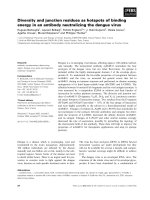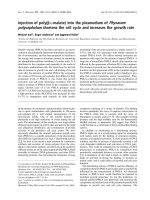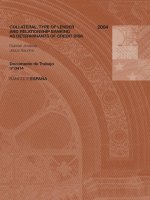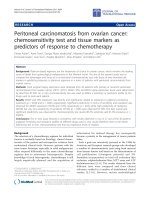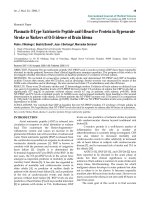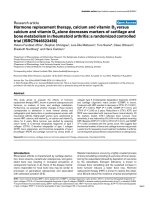Inhibin B and anti-Müllerian hormone as markers of gonadal function after hematopoietic cell transplantation during childhood
Bạn đang xem bản rút gọn của tài liệu. Xem và tải ngay bản đầy đủ của tài liệu tại đây (352.47 KB, 8 trang )
Laporte et al. BMC Pediatrics 2011, 11:20
/>
RESEARCH ARTICLE
Open Access
Inhibin B and anti-Müllerian hormone as markers
of gonadal function after hematopoietic cell
transplantation during childhood
Sylvie Laporte1, Ana-Claudia Couto-Silva2, Séverine Trabado3, Pierre Lemaire4, Sylvie Brailly-Tabard3,
Hélène Espérou5, Jean Michon6, André Baruchel7, Alain Fischer8, Christine Trivin9, Raja Brauner1*
Abstract
Background: It is difficult to predict the reproductive capacity of children given hematopoietic cell transplantation
(HCT) before pubertal age because the plasma concentrations of follicle-stimulating hormone (FSH) and luteinizing
hormone (LH) are not informative and no spermogram can be done.
Methods: We classified the gonadal function of 38 boys and 34 girls given HCT during childhood who had
reached pubertal age according to their pubertal development and FSH and LH and compared this to their plasma
inhibin B and anti-Müllerian hormone (AMH).
Results: Ten (26%) boys had normal testicular function, 16 (42%) had isolated tubular failure and 12 (32%) also had
Leydig cell failure. All 16 boys given melphalan had tubular failure. AMH were normal in 25 patients and decreased
in 6, all of whom had increased FSH and low inhibin B.
Seven (21%) girls had normal ovarian function, 11 (32%) had partial and 16 (47%) complete ovarian failure. 7/8 girls
given busulfan had increased FSH and LH and 7/8 had low inhibin B. AMH indicated that ovarian function was
impaired in all girls.
FSH and inhibin B were negatively correlated in boys (P < 0.0001) and girls (P = 0.0006). Neither the age at HCT
nor the interval between HCT and evaluation influenced gonadal function.
Conclusion: The concordance between FSH and inhibin B suggests that inhibin B may help in counselling at
pubertal age. In boys, AMH were difficult to use as they normally decrease when testosterone increases at puberty.
In girls, low AMH suggest that there is major loss of primordial follicles.
Background
Conditioning for hematopoietic cell transplantation
(HCT) may alter the production of gonadal hormones
(testosterone in boys, estradiol and progesterone in
girls) and the viability of the germ cells. Gonadal failure
may result in incomplete sexual development and
growth at puberty, and sterility in adulthood. Thus,
gonadal hormones are required for the development of
secondary sexual characteristics and the growth spurt
which normally occurs at puberty.
* Correspondence:
1
Université Paris Descartes and AP-HP, Hôpital Bicêtre, Unité
d’Endocrinologie Pédiatrique, 94270 Le Kremlin Bicêtre, France
Full list of author information is available at the end of the article
There are few reports of patients given HCT during
childhood being fertile (2 boys and 3 girls in Salooja [1],
2 boys and 9 girls in Sanders [2]). Sanders et al [2]
showed that 15 (13%) of 114 prepubertal boys developed
normal testicular function and the partners of 2 of them
became pregnant; the great majority of those who recovered testicular function had been given cyclophosphamide without irradiation. In parallel, 23 (28%) of 82
prepubertal girls developed normal ovarian function, 9
of whom became pregnant; the pregnancies of all 5
given total body irradiation (TBI) ended in spontaneous
abortion.
It is difficult to predict the reproductive capacity of a
child before pubertal age because the plasma concentrations of follicle-stimulating hormone (FSH) and
© 2011 Laporte et al; licensee BioMed Central Ltd. This is an Open Access article distributed under the terms of the Creative Commons
Attribution License ( which permits unrestricted use, distribution, and reproduction in
any medium, provided the original work is properly cited.
Laporte et al. BMC Pediatrics 2011, 11:20
/>
Page 2 of 8
luteinizing hormone (LH) are not informative and no
spermogram can be done. The plasma concentrations of
inhibin B and anti-Müllerian hormone (AMH) might be
helpful at this age. In boys, inhibin B is produced by the
Sertoli cells. Its plasma concentration is the best plasma
marker of spermatogenesis [3-5]. A study of 218 subfertile men found that their inhibin B concentration accurately (95%) differentiated between competent and
impaired spermatogenesis, while the FSH concentration
was less accurate (80%) [5]. In girls, inhibin B is produced only by the granulosa cells of small antral follicles, while AMH is produced by the granulosa cells of
pre-antral follicles, i.e. the ovarian reserve. Its plasma
concentration decreases as the number of follicles
decreases with age, with a strong correlation between
age at menopause and AMH measured between the
ages of 20 and 36 years [6].
We evaluated the gonadal function of 72 patients
given HCT during childhood after they had reached
pubertal age. The objectives were: 1) to compare the
evaluation of gonadal function by pubertal stage, testicular volume in boys and menstrual pattern in girls,
plasma FSH and LH concentrations to the plasma concentrations of inhibin B and AMH; 2) to evaluate the
influence of the age at HCT, and the interval between
HCT and evaluation, conditioning and, for chemotherapy, the use of cyclophosphamide, busulfan and melphalan on gonadal function.
Methods
Patients
This retrospective single center study included 72
patients (38 boys, 34 girls) given HCT between 1976
and 2006 (median 1991, Table 1) and followed by
one of us (R. Brauner) in a university pediatric hospital.
Table 1 Patient characteristics
Age at HCT, yr
Age at evaluation, yr
Interval between HCT and
evaluation, yr
Boys (n = 38)
Girls (n = 34)
8.2 ± 0.6
7.0 ± 0.6
(1.0-15)
(0.6-13)
16.5 ± 0.3
13.9 ± 0.3
(13.2-21.3)
(11-17.3)
8.3 ± 0.6
6.9 ± 0.6
Total
(1.1-16.0)
(1.5-14.4)
Initial disease (n)
Malignant
35
26
61
Non malignant
3
8
11
TBI
34
24
58
TLI
3
3
6
Chemotherapy alone
1
7
8
Conditioning, n
mean ± se (range)
The boys were younger than 15 years (8.2 ± 0.6 yr) at
HCT and the girls younger than 13 years (7.0 ± 0.6 yr).
Puberty began in 3 boys and 2 girls at HCT. They had
reached pubertal age (over 13 years for boys and 11
years for girls) when their gonadal function was evaluated. The interval between HCT and evaluation was 8.3
± 0.6 yr in boys and 6.9 ± 0.6 yr in girls.
The initial diseases were malignant [acute lymphoblastic leukemia (n = 31), acute myeloid leukemia (n = 16),
chronic myelogenous leukemia (n = 3), lymphoma (n =
5), neuroblastoma (n = 5), nephroblastoma (n = 1)], or
non-malignant [severe aplastic anemia (n = 6), congenital immunodeficiency (n = 4), myelodysplasia (n = 1)].
Of the patients with malignant disease, 34 were given
HCT in first remission and 27 in second or third remission. The patients were allografted (70%) or autografted
(30%). The conditioning protocol for HCT included chemotherapy in all, TBI 12 Grays (Gy) as six fractions of 2
Gy over 3 consecutive days, or a single dose 10 Gy TBI,
5 or 6 Gy total lymphoid irradiation (TLI) as single 4-h
exposures or chemotherapy alone (Table 1). The total
chemotherapy doses were cyclophosphamide (120, 150
or 200 mg/kg according to the disease), melphalan (140
mg/m2) and/or busulfan (600 mg/m2). The other drugs
were cytarabine in 12 (18 or 24 g/m2 ), etoposide in 5
(400 mg/m2), methotrexate in 4 and vincristine in 5.
Fifteen other boys and 11 girls were excluded because
no samples were available for measuring inhibin B.
Their characteristics were similar to those who were
included. Another 75 patients seen during the same period and fulfilling these criteria were excluded because
they had factors other than conditioning for HCT that
might have interfered with their gonadal function: the
initial disease [Fanconi’s anemia (n = 19), Blackfan-Diamond anemia (n = 3), thalassemia (n = 3), drepanocytosis (n = 2), Seckel disease (n = 1)], central nervous
system involvement or additional irradiation (n = 47).
Protocol
Informed consent for evaluation and treatment was
obtained from the patients and their parents. The Ethical Review Committee (Comité de Protection des Personnes Ile de France III) stated that ‘’This research was
found to conform to generally accepted scientific principles and research ethical standards and to be in conformity with the laws and regulations of the country in
which the research experiment was performed”.
We recorded testicular dimensions [7] and pubic hair
development in the boys [8]. Because the testicular
dimensions may be altered by the tubular failure caused
by the conditioning protocol, the pubertal stage was
defined by the pubic hair development and the plasma
testosterone concentration: P1 - below 0.5 ng/mL, P2 0.5-2 ng/mL, P3 - 2-3 ng/mL and P4-5 over 3 ng/mL
Laporte et al. BMC Pediatrics 2011, 11:20
/>
[adapted from 9]. We recorded the age at breast development and the occurrence and progress of their menstruations in the girls [10]. Plasma samples were
collected before the substitutive treatment except in 5
girls in whom the estradiol treatment was interrupted
for at least 2 months (see below), and a long time after
graft versus host disease. We measured the basal plasma
concentrations of FSH, LH and testosterone in boys and
estradiol in girls. Aliquots of plasma were frozen at -20°
C and used to measure concomitant plasma inhibin B
(in all) and AMH (31 boys and 25 girls) concentrations.
We used the last sample taken from patients who had
undergone more than one laboratory evaluation.
Normal gonadal function was defined by the occurrence of spontaneous puberty in both sexes, plus regular
menstruations in girls, and normal basal plasma FSH
(< 9 IU/L) and LH (< 5 IU/L) concentrations. In boys,
tubular failure was defined by an increased plasma FSH
concentration, and Leydig cell failure by an increased
plasma LH concentration with a normal (partial failure)
or low (complete failure) plasma testosterone concentration. The normal basal testosterone concentration in
adult boys is 3.5-8.5 ng/mL. In girls, ovarian failure was
defined by increased plasma FSH and/or LH concentrations, which is partial when pubertal development is
spontaneous and plasma estradiol is normal, and complete when pubertal development is partial or absent
and plasma estradiol low.
Two boys with partial and the one with complete Leydig cell failure were given testosterone heptylate (25 mg
i.m. every 14 days) at the age of around 13 years. Seven
girls with partial and the 16 with complete ovarian failure were given oral ethinyl estradiol (2 μg/day) at the
age of around 12 years. The doses were increased to
adult levels, and associated with cyclical progestin in
girls when they had finished growing.
The growth hormone (GH) secretion of the patients
given TBI who had a decreased growth rate was evaluated by a stimulation test. The test was repeated in
those with a low peak to decide on GH treatment, and
in those whose growth rate remained low despite a normal GH peak [11]. Twenty-four patients were given GH.
Plasma cortisol and prolactin concentrations were normal in all patients. The 32 patients with high plasma
thyroid stimulating hormone concentrations after TBI
or TLI were given thyroxin (50 μg/m2/day).
Methods
When the assay method for a given hormone was changed during the study period, it was cross-correlated with
the earlier method. Thus, the results are comparable
throughout the whole period.
The plasma concentrations of inhibin B and AMH
were measured in serum by enzyme immunometric
Page 3 of 8
assays (Oxford Bio-Innovation reagents, Serotec, Oxford,
UK for inhibin B and Immunotech reagents, Beckman
Coulter Company, Marseille, France for AMH). The
lower limit of detection was 10 pg/mL for inhibin B and
1 pmol/L for AMH. Their concentrations were compared to the normal values [9,12]
Data are expressed as means ± se. The differences
between groups were analyzed by a Kruskall Wallis test,
followed by Mann-Whitney tests. Correlations were
made with the Spearman rank test. We also analysed
the factors associated with abnormal gonadal function
using standard statistical tools and Weka Data Mining
software [13].
Results
Gonadal function and the plasma inhibin B concentrations did not differ with the type of HCT (allograft or
autograft), or of TBI (single 10 or fractionated 12 Gy).
We therefore analysed all the data together.
1. Boys
The plasma FSH and LH concentrations indicated that
10 (26%) boys had normal testicular function and 28
(74%) had abnormal function (Table 2). Of the latter, 16
(42%) had isolated tubular failure and 12 (32%) also had
Leydig cell failure (11 partial and one complete). The
mean plasma inhibin B and AMH concentrations were
significantly higher in the boys with normal testicular
function than in those with tubular failure, and among
these latter higher in those with isolated tubular failure
than in those with tubular and Leydig cell failures.
Among the 3 boys given HCT after the onset of puberty, the two given TBI and cyclophosphamide had normal testicular function and the one given TBI,
melphalan and vincristin had tubular failure.
The 10 boys with normal FSH and LH concentrations
included 8 who were given TBI for acute lymphoblastic
leukemia (n = 2), acute myeloid leukemia (n = 5), and
chronic myelogenous leukemia (n = 1), one who was
given TLI for severe aplastic anemia, and one who was
given chemotherapy alone (aracytine and busulfan) at
one year for acute lymphoblastic leukemia. All, except
the 3 treated for acute lymphoblastic leukemia, were
given cyclophosphamide alone.
All 16 boys who were given melphalan had increased
plasma FSH, and 14/16 had decreased inhibin B concentrations (Figure 1). The melphalan was combined with
TLI in one case and with TBI in the others (single 10
Gy in four and fractionated 12 Gy in eleven cases).
The plasma AMH concentrations were normal in 25
patients and decreased in 6, all of whom had increased
FSH and low inhibin B concentrations (Figure 1). The
plasma inhibin B concentrations were normal in 10 and
decreased in 28 boys. There were dissociations between
Laporte et al. BMC Pediatrics 2011, 11:20
/>
Page 4 of 8
Table 2 Features of testis function after HCT
FSH
Patients
350
Normal Abnormal
n (%)
n (%)
10 (26)
28 (74)
Conditioning
300
TBI
TLI
Chemotherapy alone
250
Age at HCT, yr
8.6 ±
1.3
8.1 ± 0.6
Age at evaluation, yr
15.8 ±
0.5
16.7 ± 0.4
Interval between HCT and
evaluation, yr
7.3 ±
1.5
8.6 ± 0.6
Inhibin B, pg/mL
200
150
100
* a
a
Conditioning
*
TBI
8 (23)
26 (77)
TLI
1 (33)
2 (67)
Chemotheray alone
1
Cyclophosphamide
+9 (45)
11 (55)
-1 (5)
+1
(100)
-9 (24)
17 (95)
28 (76)
+0
16 (100)
Melphalan
P1
202 ±
58
P2
P3
*
**
*
*
P4
P5
800
Conditioning
TBI
700
TLI
Chemotherapy alone
600
-10 (45) 12 (55)
Inhibin B, pg/mL
**
0
*
**
*
*
35 ± 5*
500
AMH, pmol/L
Busulfan
50
*
*
400
300
200
n = 10
Tubular failure, n = 16
100
47 ± 7**
Tubular and Leydig cell
failures, n = 12
0
P1
20 ± 3
AMH, pmol/L
195 ±
86
41 ± 6***
n=8
Tubular failure, n = 14
51 ± 7****
Tubular and Leydig cell
failures, n = 9
24 ± 6
mean±se.
P*<0.0001 compared to normal.
P**=0.01 compared to tubular and Leydig cell failures.
P***<0.005 compared to normal testis function.
P****<0.02 compared to tubular and Leydig cell failure.
the plasma FSH and inhibin B concentrations in 3
patients: one boy with normal FSH had low inhibin B
(55 pg/mL); conversely two boys with increased FSH (10
and 11 IU/L) had normal inhibin B (79 and 95 pg/mL).
These 3 patients included 2 with testicular volumes
greater than 10 mL.
The plasma inhibin B concentrations were positively correlated with those of AMH and negatively correlated with
those of FSH (Rho = 0.71, P < 0.0001 for both), but not
with the age at HCT, interval between HCT and evaluation,
testicular volume, which was negatively correlated with the
plasma FSH concentrations (Rho = -0.46, P < 0.006).
P2
P3
P4
P5
Pubertal stage
Figure 1 Distributions of plasma inhibin B and antimüllerian
hormone (AMH) in boys given hematopoietic cell
transplantation according to the conditioning protocol. Broken
lines to the 5th and 95th percentiles9,12; *indicates those given
melphalan; aindicates the 2 boys with increased FSH (10 and 11 IU/
L) and normal inhibin B.
Data Mining analysis showed that the factors associated with increased plasma FSH concentrations were
melphalan treatment, no cyclophosphamide treatment,
and a low inhibin B concentration: all 22 boys with an
inhibin B concentration below 55 pg/mL had increased
plasma FSH concentrations, while all 7 of the boys
whose inhibin B concentration was above 100 pg/mL
had normal plasma FSH and LH concentrations.
2. Girls
Menarche had occurred spontaneously in 11 girls, 6 of
whom had normal FSH and LH concentrations and 5
had partial ovarian failure.
The plasma FSH and LH concentrations indicated that
7 (21%) girls had normal ovarian function and 27 (79%)
had ovarian failure (11 partial and 16 complete, Table 3).
The mean plasma inhibin B concentrations were significantly higher in the girls with normal ovarian function
Laporte et al. BMC Pediatrics 2011, 11:20
/>
Table 3 Features of ovarian function after HCT
Ovarian function
Normal Abnormal
n (%)
n (%)
Patients
7 (21)
27 (79)
Age at HCT, yr
5.3 ±
1.2
7.4 ± 0.7
Age at evaluation, yr
14.7 ±
0.6
13.7 ± 0.3
Interval between HCT and
evaluation, yr
9.4 ±
0.8
6.3 ± 0.7
TBI
3 (13)
21 (87)
TLI
1 (33)
2 (67)
Chemotheray alone
3 (43)
4 (57)
Cyclophosphamide
+ 4 (18)
18 (82)
-
3 (25)
9 (75)
+ 1 (12)
7 (88)
-
20 (77)
Conditioning
Busulfan
Melphalan
Inhibin B, pg/mL
6 (23)
+ 3 (30)
7 (70)
-
20 (83)
4 (17)
87 ± 20 18.6 ± 4.3*
n=7
Partial ovarian failure, n =
11
26.9 ± 10ª
Complete ovarian failure,
n = 16
AMH, pmol/L
Page 5 of 8
were normal in 6 and decreased in 28 girls (Figure 2).
There were dissociations between the plasma FSH/LH
and inhibin B concentrations in 2 patients: one girl given
cyclophosphamide and busulfan without irradiation had
normal FSH and LH and low inhibin B (22 pg/mL) at
12.2 years; conversely, one girl with increased FSH/LH
had normal inhibin B (124 pg/mL) with few spontaneous
menstruations.
The plasma inhibin B concentrations were negatively
correlated with those of FSH (Rho = -0.6, P = 0.0006),
but not with the age at HCT or the interval between
HCT and evaluation.
Data Mining analysis showed that the factors associated with increased plasma FSH/LH concentrations
were busulfan and a low inhibin B concentration: the
inhibin B concentration was below 40 pg/mL in 26 of
the 27 girls with increased LH/FSH concentrations,
while it was above 40 pg/mL in 6 of the 7 girls (above
100 pg/mL in 5 girls) with normal plasma FSH and LH
concentrations.
Discussion
We have evaluated the specific effect of conditioning for
HCT on the gonads. Any patient having other factors
that might have interfered with their gonadal function
was excluded, except the 27 given HCT in the second
or third remission who were previously given chemotherapy without irradiation.
12.9 ± 1.1
1. Boys
0.7 ±
0.4
0.1 ± 0.1ª
Their plasma FSH and LH concentrations indicated that
26% of our boys had normal testicular function. These
n=7
n = 18
Ovarian function
mean ± se.
a: NS.
P* = 0.0003 compared to normal ovarian function.
350
Conditioning
300
TBI
TLI
Chemotherapy alone
250
Inhibin B, pg/mL
than in those with ovarian failure, and among these latter
higher in those with partial ovarian failure than in those
with complete failure. The two girls given HCT after the
onset of puberty suffered from ovarian failure.
The 7 girls with normal FSH and LH concentrations
included 3 who were given TBI for acute lymphoblastic
leukemia (n = 2) or acute myeloid leukemia (n = 1), one
who was given TLI for severe aplastic anemia and 3
who were given chemotherapy alone for congenital
immunodeficiency (= 2) or nephroblastoma.
Among the 8 girls given busulfan, combined with TBI in
two, 7 had increased plasma FSH and LH concentrations
and 7/8 had low inhibin B with dissociation in one case.
The plasma AMH concentrations were very low,
between 0 and 2 pmol/L, including in the 7 with normal
ovarian function. The plasma inhibin B concentrations
200
150
a
100
50
*
*a
0
Normal
*
*
*
Partial failure
*
*
*
Complete failure
Figure 2 Distributions of plasma inhibin B in girls given
hematopoietic cell transplantation according to the ovarian
function and conditioning protocol. *indicates those given
busulfan; aindicates the 2 girls with dissociations between
gonadotropin and inhibin B concentrations.
Laporte et al. BMC Pediatrics 2011, 11:20
/>
figures are higher than those reported by Sanders et al
[2] (13%) and Van Casteren et al [14] who reported that
the 10 boys given TBI 7.5 or 12 Gy before HCT had
almost undetectable (< 26 pg/mL, n = 8) or 26-62 pg/
mL (n = 2) inhibin B concentrations; the severity of
gonadal dysfunction in this study may be partly due to
the additional testicular radiotherapy given to 5/10 boys.
The differences might also be explained by differences
in the age at HCT and/or the interval between HCT
and evaluation. However, these two factors did not
influence testicular function in our study. The wide
ranges of the age at HCT and the interval between HCT
and evaluation, and the limited study population might
partly explain the absence of any significant impact of
these factors in our study.
Melphalan seemed to be more gonadotoxic, giving rise
to increased FSH (in all 16) and decreased inhibin B (in
14 of them) concentrations. This effect of melphalan
was also seen by Crofton et al [15], who showed that
inhibin B was normal before, during and after treatment
in 16 boys given chemotherapy for solid tumors or
acute lymphoblastic leukemia, except in one who had
undetectable inhibin B after cyclophosphamide plus cisplatin plus melphalan. However conclusions cannot
easily be drawn as the effect of the drug cannot be separated from that of irradiation.
Our study confirms the excellent correlation and concordance between the plasma concentrations of FSH
and inhibin B that was reported by Cicognani et al [16].
They showed that all boys who have increased FSH (>
6.1 IU/L) or LH (> 5.8 IU/L) concentrations also had
inhibin B concentrations below 112 pg/mL (-2 standard
deviations). Unlike Lähteenmäki et al [17], we found no
correlation between testicular volume and inhibin B (P
= 0.06). They reported that patients with small testes (<
10 mL) after treatment for childhood malignancy had
inhibin B concentrations below 42 pg/mL, and 6 out of
7 had FSH concentrations above 9 IU/L; patients with a
testicular volume above 13 mL had inhibin B concentrations above 100 pg/mL. This difference might be
explained by variations in the age at which the boys in
our study were given HCT and evaluated.
We find that the plasma AMH concentration does not
seem to be a good marker, as it normally decreases
when testosterone increases at puberty.
We did not carry out a sperm analysis because our
boys were too young. However, the reported relationship
between inhibin B and the sperm count in normal men
and in boys surviving a childhood malignancy suggests
that 10/38 (based on FSH or inhibin B) or 7/38 (based
on both) of the boys we studied will be normospermic.
Thomson et al [18] showed that inhibin B was barely
detectable in azoospermic patients whose germ cells had
been destroyed, despite preservation of their Sertoli
Page 6 of 8
cells, as confirmed by testicular biopsy. Van Beek et al
[19] showed that inhibin B is a better marker of spermatogenesis than is the FSH concentration in men given
chemotherapy for Hodgkin’s lymphoma as children.
Multivariate analysis with inhibin B and FSH concentrations as determinants of sperm concentration showed
that inhibin B was the only significant determinant; all
the men with a plasma inhibin B concentration above
75 pg/mL were normospermic. Lähteenmäki et al [20]
showed that the inhibin B and FSH concentrations and
the testicular volume explain 44% of the variance in the
sperm count. Van Casteren et al [14] found that their 5
patients who were normospermic had inhibin B concentrations of 125-234 pg/mL, while the corresponding
values in the 9 azoospermic patients was 0-79 pg/mL,
with a correlation between sperm count and inhibin B
concentrations.
2. Girls
Their plasma FSH and LH concentrations indicate that
21% of our girls had normal ovarian function. These figures are similar to those reported by others [2,21,22].
However, the girls in our study with spontaneous puberty were no younger at HCT than were those with
ovarian failure. Similarly, the FSH, inhibin B and AMH
concentrations were not influenced by age or pubertal
status at treatment. Fong et al [23] studied women treated for cancer during childhood and found that those
with undetectable AMH were significantly older at diagnosis, only 2/17 had regular menstrual cycles, and more
of them had been given body or abdomen radiotherapy
than those with greater AMH concentrations. The preeminence of the role of the irradiation and of busulfan
might partly explain why the age at HCT has no significant impact on ovarian function in our study.
Busulfan seemed to be more gonadotoxic. Of the 8
girls given busulfan, combined with TBI in two, 7 had
increased plasma FSH/LH concentrations and 7/8 had
low inhibin B. This effect of busulfan was also seen by
Teinturier et al [24], who showed that the 10 girls given
busulfan (600 mg/m2 ) without TBI before autologous
HCT all developed severe, persistent ovarian failure.
They identified 26 of 29 girls in published reports given
busulfan during prepuberty or puberty as having signs
of ovarian failure.
Larsen et al [25] used multiple linear regression analysis of 100 girls who had survived childhood malignancy
to predict the total number of antral follicles per ovary.
Ovarian irradiation, alkylating chemotherapy, older age
at diagnosis and a long period off treatment all reduced
the number of follicles. Among the 10 girls conditioned
for HCT by TBI, the 3 with spontaneous cycles had
smaller ovaries, fewer total follicles and higher FSH than
the others.
Laporte et al. BMC Pediatrics 2011, 11:20
/>
We have therefore confirmed the excellent correlation
and concordance between the plasma concentrations of
FSH and inhibin B, and agreement with the clinical evolution, while those of AMH were very low. The 7 girls
with normal puberty and FSH and LH all had AMH
concentrations similar to those with ovarian failure.
Three [23,26,27] studies have evaluated the capacity of
plasma AMH concentrations to assess the ovarian
damage in adults surviving childhood malignancy. Bath
et al [26] compared 10 girls treated for cancer during
childhood, all with regular menstrual cycles, with 11
controls. The treated girls had smaller ovaries than the
controls and significantly higher FSH and lower AMH
concentrations, while the other hormone concentrations
were unchanged. Thus, the AMH concentration indicates a depletion of ovarian reserve, despite regular
menstrual cycles. Van Beek et al [27] showed that girls
treated with MOPP (mechlorethamine, oncovin, prednisone, procarbazine) for Hodgkin’s lymphoma during
childhood developed into women with elevated FSH
concentrations and decreased AMH concentrations.
Three of the women with normal FSH had decreased
AMH.
Conclusions
In boys, the concordance between plasma FSH and inhibin B concentrations suggests that measuring inhibin B
may help in counselling at pubertal age. Plasma AMH
concentrations do not seem to be a good marker as they
normally decrease when testosterone increases at puberty. All or most of the boys given melphalan, when
combined with TBI or TLI, will be azoospermic.
In girls, there is also a good concordance between
plasma FSH and inhibin B concentrations. Both were
normal in 6/34 girls who had normal puberty and regular
menstruations, but their very low AMH concentrations
suggest that there is a major loss of primordial follicles.
One limitation of this study is the range of drugs used.
The fact that the drug effect could not be separated
from that of irradiation significantly limits our ability to
draw any conclusion about the effects of melphalan or
busulfan.
Abbreviations
AMH: antimüllerian hormone; FSH: follicle-stimulating hormone, growth
hormone - GH; Gy: Grays; HCT: hematopoietic cell transplantation; LH:
luteinizing hormone; TLI: total lymphoid irradiation; TBI: total body
irradiation.
Acknowledgements
We thank Monique Pouillot for technical help and Dr Owen Parkes for
editing the manuscript.
Author details
1
Université Paris Descartes and AP-HP, Hôpital Bicêtre, Unité
d’Endocrinologie Pédiatrique, 94270 Le Kremlin Bicêtre, France. 2State of
Page 7 of 8
Bahia, Center for Diabetes and Endocrinology (CEDEBA), Bahia, Brazil. 3AP-HP,
Hôpital Bicêtre, Laboratoire de Génétique moléculaire, Pharmacogénétique
et Hormonologie, and Univ Paris Sud, 94270 Le Kremlin Bicêtre, France. 4GSCOP, INP-Grenoble, UJF, CNRS, 38000 Grenoble, France. 5AP-HP, Hôpital
Saint Louis, Service d’ Hématologie-Greffes de Moelle, 75475 Paris, France.
6
Institut Curie, Département d’Oncologie Pédiatrique, 75248 Paris, France.
7
AP-HP and Université Paris7 Paris-Diderot, Hôpital Robert Debré, Service
d’Hématologie Pédiatrique, 75019 Paris, France. 8Université Paris Descartes
and AP-HP, Hôpital Necker-Enfants Malades, Unité d’Immunologie,
Hématologie et Rhumatologie Pédiatriques, 75743 Paris, France. 9AP-HP,
Hôpital Necker-Enfants Malades, Service d’Explorations Fonctionnelles, 75743
Paris, France.
Authors’ contributions
SL and AC-CS participated in the design of the study, data acquisition and
analysis. ST and SBT carried out the immunoassays. PL and CT performed
the statistical analyses. CT prepared the tables and the figures. HE, JM, AB
and AF followed the patients and participated in the design of the study. RB
directed the work and prepared the manuscript. All authors read and
approved the final manuscript.
Competing interests
The authors declare that they have no competing interests.
Received: 22 July 2010 Accepted: 25 February 2011
Published: 25 February 2011
References
1. Salooja N, Szydlo RM, Socie G, Rio B, Chatterjee R, Ljungman P, et al:
Pregnancy outcomes after peripheral blood or bone marrow
transplantation: a retrospective survey. Lancet 2001, 358(9278):271-276.
2. Sanders JE, Hawley J, Levy W, Gooley T, Buckner CD, Deeg HJ, et al:
Pregnancies following high-dose cyclophosphamide with or without
high-dose busulfan or total-body irradiation and bone marrow
transplantation. Blood 1996, 87(7):3045-3052.
3. Andersson AM, Petersen JH, Jorgensen N, Jensen TK, Skakkebaek NE: Serum
inhibin B and follicle-stimulating hormone levels as tools in the
evaluation of infertile men: significance of adequate reference values
from proven fertile men. J Clin Endocrinol Metab 2004, 89(6):2873-2879.
4. Jensen TK, Andersson AM, Hjollund NH, Scheike T, Kolstad H, Giwercman A,
et al: Inhibin B as a serum marker of spermatogenesis: correlation to
differences in sperm concentration and follicle-stimulating hormone
levels. A study of 349 Danish men. J Clin Endocrinol Metab 1997,
82(12):4059-4063.
5. Pierik FH, Vreeburg JT, Stijnen T, De Jong FH, Weber RF: Serum inhibin B
as a marker of spermatogenesis. J Clin Endocrinol Metab 1998,
83(9):3110-3114.
6. van Rooij IA, Tonkelaar I, Broekmans FJ, Looman CW, Scheffer GJ, de
Jong FH, et al: Anti-mullerian hormone is a promising predictor for the
occurrence of the menopausal transition. Menopause 2004, 11(6 Pt
1):601-606.
7. Burr IM, Sizonenko PC, Kaplan SL, Grumbach MM: Hormonal changes in
puberty. I. Correlation of serum luteinizing hormone and follicle
stimulating hormone with stages of puberty, testicular size, and bone
age in normal boys. Pediatr Res 1970, 4(1):25-35.
8. Marshall WA, Tanner JM: Variations in the pattern of pubertal changes in
boys. Arch Dis Child 1970, 45:13-23.
9. Andersson AM, Juul A, Petersen JH, Muller J, Groome NP, Skakkebaek NE:
Serum inhibin B in healthy pubertal and adolescent boys: relation to
age, stage of puberty, and follicle-stimulating hormone, luteinizing
hormone, testosterone, and estradiol levels. J Clin Endocrinol Metab 1997,
82(12):3976-3981.
10. Marshall WA, Tanner JM: Variations in pattern of pubertal changes in
girls. Arch Dis Child 1969, 44:291-303.
11. Couto-Silva AC, Trivin C, Esperou H, Michon J, Baruchel A, Lemaire P, et al:
Final height and gonad function after total body irradiation during
childhood. Bone Marrow Transplant 2006, 38(6):427-432.
12. Rey RA, Belville C, Nihoul-Fekete C, Michel-Calemard L, Forest MG, Lahlou N,
et al: Evaluation of gonadal function in 107 intersex patients by means
of serum antimullerian hormone measurement. J Clin Endocrinol Metab
1999, 84(2):627-631.
Laporte et al. BMC Pediatrics 2011, 11:20
/>
Page 8 of 8
13. Witten IHFE: Data Mining. Elsevier;, Second 2005.
14. van Casteren NJ, van der Linden GH, Hakvoort-Cammel FG, Hahlen K,
Dohle GR, van den Heuvel-Eibrink MM: Effect of childhood cancer
treatment on fertility markers in adult male long-term survivors. Pediatr
Blood Cancer 2009, 52(1):108-112.
15. Crofton PM, Thomson AB, Evans AE, Groome NP, Bath LE, Kelnar CJ, et al: Is
inhibin B a potential marker of gonadotoxicity in prepubertal children
treated for cancer? Clin Endocrinol (Oxf) 2003, 58(3):296-301.
16. Cicognani A, Cacciari E, Pasini A, Burnelli R, De Iasio R, Pirazzoli P, et al: Low
serum inhibin B levels as a marker of testicular damage after treatment
for a childhood malignancy. Eur J Pediatr 2000, 159(1-2):103-107.
17. Lahteenmaki PM, Toppari J, Ruokonen A, Laitinen P, Salmi TT: Low serum
inhibin B concentrations in male survivors of childhood malignancy. Eur
J Cancer 1999, 35(4):612-619.
18. Thomson AB, Campbell AJ, Irvine DC, Anderson RA, Kelnar CJ, Wallace WH:
Semen quality and spermatozoal DNA integrity in survivors of childhood
cancer: a case-control study. Lancet 2002, 360(9330):361-367.
19. van Beek RD, Smit M, van den Heuvel-Eibrink MM, de Jong FH, HakvoortCammel FG, van den Bos C, et al: Inhibin B is superior to FSH as a serum
marker for spermatogenesis in men treated for Hodgkin’s lymphoma
with chemotherapy during childhood. Hum Reprod 2007,
22(12):3215-3222.
20. Lahteenmaki PM, Arola M, Suominen J, Salmi TT, Andersson AM, Toppari J:
Male reproductive health after childhood cancer. Acta Paediatr 2008,
97(7):935-942.
21. Sarafoglou K, Boulad F, Gillio A, Sklar C: Gonadal function after bone
marrow transplantation for acute leukemia during childhood. J Pediatr
1997, 130(2):210-216.
22. Matsumoto M, Shinohara O, Ishiguro H, Shimizu T, Hattori K, Ichikawa M,
et al: Ovarian function after bone marrow transplantation performed
before menarche. Arch Dis Child 1999, 80(5):452-454.
23. Fong SL, Laven JSE, Hakvoort-Cammel FGAJ, Schipper I, Visser JA,
Themmen APN, de Jong FH, van den Heuvel-Eibrink MM: Assessment of
ovarian reserve in adult childhood cancer survivors using anti-Müllerian
hormone. Hum Reprod 2009, 24(4):982-990.
24. Teinturier C, Hartmann O, Valteau-Couanet D, Benhamou E, Bougneres PF:
Ovarian function after autologous bone marrow transplantation in
childhood: high-dose busulfan is a major cause of ovarian failure. Bone
Marrow Transplant 1998, 22(10):989-994.
25. Larsen EC, Muller J, Schmiegelow K, Rechnitzer C, Andersen AN: Reduced
ovarian function in long-term survivors of radiation- and chemotherapytreated childhood cancer. J Clin Endocrinol Metab 2003, 88(11):5307-5314.
26. Bath LE, Wallace WH, Shaw MP, Fitzpatrick C, Anderson RA: Depletion of
ovarian reserve in young women after treatment for cancer in
childhood: detection by anti-Mullerian hormone, inhibin B and ovarian
ultrasound. Hum Reprod 2003, 18(11):2368-2374.
27. van Beek RD, van den Heuvel-Eibrink MM, Laven JS, de Jong FH,
Themmen AP, Hakvoort-Cammel FG, et al: Anti-Mullerian hormone is a
sensitive serum marker for gonadal function in women treated for
Hodgkin’s lymphoma during childhood. J Clin Endocrinol Metab 2007,
92(10):3869-3874.
Pre-publication history
The pre-publication history for this paper can be accessed here:
/>doi:10.1186/1471-2431-11-20
Cite this article as: Laporte et al.: Inhibin B and anti-Müllerian hormone
as markers of gonadal function after hematopoietic cell transplantation
during childhood. BMC Pediatrics 2011 11:20.
Submit your next manuscript to BioMed Central
and take full advantage of:
• Convenient online submission
• Thorough peer review
• No space constraints or color figure charges
• Immediate publication on acceptance
• Inclusion in PubMed, CAS, Scopus and Google Scholar
• Research which is freely available for redistribution
Submit your manuscript at
www.biomedcentral.com/submit
